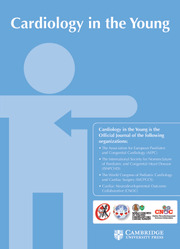Crossref Citations
This article has been cited by the following publications. This list is generated based on data provided by
Crossref.
2003.
The Natural and Modifed History of Congenital Heart Disease.
p.
601.
Marasini, Maurizio
Zannini, Lucio
Ussia, Gian Paolo
Pinto, Robin
Moretti, Rodolfo
Lerzo, Franco
and
Pongiglione, Giacomo
2003.
Discrete subaortic stenosis: incidence, morphology and surgical impact of associated subaortic anomalies.
The Annals of Thoracic Surgery,
Vol. 75,
Issue. 6,
p.
1763.
Freedom, Robert M.
Yoo, Shi-Joon
Russell, Jennifer
Perrin, Donald
and
Williams, William G.
2005.
Thoughts about fixed subaortic stenosis in man and dog.
Cardiology in the Young,
Vol. 15,
Issue. 2,
p.
186.
Zannini, Lucio
and
Borini, Italo
2007.
State of the art of cardiac surgery in patients with congenital heart disease.
Journal of Cardiovascular Medicine,
Vol. 8,
Issue. 1,
p.
3.
Yuan, Shi‐Min
Shinfeld, Amihay
Mishaly, David
Haizler, Rami
Ghosh, Probal
and
Raanani, Ehud
2008.
Accessory Mitral Valve Tissue: A Case Report and an Updated Review of Literature.
Journal of Cardiac Surgery,
Vol. 23,
Issue. 6,
p.
769.
Schumacher, G.
2008.
Klinische Kinderkardiologie.
p.
161.
Bharucha, T.
Ho, S. Y.
and
Vettukattil, J. J.
2008.
Multiplanar review analysis of three-dimensional echocardiographic datasets gives new insights into the morphology of subaortic stenosis.
European Journal of Echocardiography,
Vol. 9,
Issue. 5,
p.
614.
Cho, Young Kuk
Oh, Soo Min
Joo, Ji Won
and
Ma, Jae Sook
2010.
Secondary Subaortic Stenosis after Patch Closure of Subarterial Ventricular Septal Defect.
Journal of Cardiovascular Ultrasound,
Vol. 18,
Issue. 2,
p.
52.
Fettouhi, H.
Amri, R.
Tamdy, A.
Zarzour, J.
and
Cherti, M.
2010.
Diaphragme sous-aortique par muscularisation de grande valve mitrale : à propos de deux cas.
Annales de Cardiologie et d'Angéiologie,
Vol. 59,
Issue. 4,
p.
243.
Roubertie, F.
Le Bret, E.
Belli, E.
Roussin, R.
Ly, M.
and
Serraf, A.
2010.
Sténoses aortiques congénitales.
EMC - Techniques chirurgicales - Thorax,
Vol. 5,
Issue. 1,
p.
1.
Cittadini, Francesca
Oliva, Antonio
Arena, Vincenzo
Minelli, Natalia
and
Pascali, Vincenzo L.
2011.
Sudden Cardiac Death Due to an Anomalous Posterior Papillary Muscle.
American Journal of Forensic Medicine & Pathology,
Vol. 32,
Issue. 3,
p.
239.
Lopes, Ricardo
Lourenço, Patrícia
Gonçalves, Alexandra
Cruz, Cristina
and
Maciel, Maria Júlia
2011.
The Natural History of Congenital Subaortic Stenosis.
Congenital Heart Disease,
Vol. 6,
Issue. 5,
p.
417.
Kozak, Marcelo F.
Sivanandam, Shanthi
De Marchi, Carlos H.
Kozak, Ana Carolina Leiroz Ferreira Botelh
Croti, Ulisses A.
Moscardini, Airton C.
and
Dearani, Joseph A.
2011.
A Trileaflet “Mitral Valve” with Three Papillary Muscles: Brand New Echocardiographic Finding.
Congenital Heart Disease,
Vol. 6,
Issue. 1,
p.
70.
Silbiger, Jeffrey J.
2013.
Left Ventricular False Tendons: Anatomic, Echocardiographic, and Pathophysiologic Insights.
Journal of the American Society of Echocardiography,
Vol. 26,
Issue. 6,
p.
582.
Ozyuksel, A.
Yildirim, O.
Onsel, I.
and
Bilal, M. S.
2014.
Severe mitral regurgitation due to anterior mitral leaflet perforation after surgical treatment of discrete subaortic stenosis.
Case Reports,
Vol. 2014,
Issue. may23 1,
p.
bcr2014204463.
Etnel, Jonathan R.G.
Takkenberg, Johanna J.M.
Spaans, Laura G.
Bogers, Ad J.J.C.
and
Helbing, Willem A.
2015.
Paediatric subvalvular aortic stenosis: a systematic review and meta-analysis of natural history and surgical outcome.
European Journal of Cardio-Thoracic Surgery,
Vol. 48,
Issue. 2,
p.
212.
Pillutla, Priya
and
Cook, Stephen C.
2016.
Cardiac CT Imaging.
p.
429.
Bertail-Galoin, Claire
and
Roubertie, François
2021.
Cardiologie du Foetus et de L'enfant.
p.
347.
Faraj, Raid
Dib, Hassan
Belhoussine, Houda
Sarsari, Mohamed
Lahjouji, Reda
Bargach, Inesse
Zarzur, Jamila
and
Cherti, Mohamed
2023.
Mitral valvar anomalies causing subaortic stenosis: two rare case reports.
Annals of Medicine & Surgery,
Vol. 85,
Issue. 4,
p.
1108.
Kara, Kenan Abdurrahman
Arslanoglu, Ergin
Yigit, Fatih
Arkan, Cuneyt
Ozcan, Esra
Akardere, Omer Faruk
Cine, Nihat
Tuncer, Eylem
Cetiner, Nilufer
and
Ceyran, Hakan
2024.
The prognostic significance of early troponin levels in patients undergoing aortic ridge surgery.
Cardiology in the Young,
Vol. 34,
Issue. 2,
p.
301.




